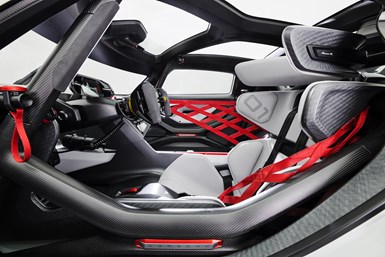Porsche races to the future with electric motors, natural fiber composites
The Mission R concept is Porsche’s vision for sustainable, all-electric customer motorsports, including a CFRP exoskeleton and natural fiber-reinforced components.

The Porsche Mission R concept: An environmentally appropriate race car. The exterior panels are based on flax fiber-reinforced plastics. And the electric vehicle has a top speed of more than 186 mph. Photo Credit, all images: Porsche
Motor racing isn’t exactly the most environmental of activities, given that there are cars and trucks speeding along tracks burning fuel in abundance. As automotive OEMs work to burnish their “green” credentials, the justification of motorsports becomes more difficult.
That is, unless the “motor” isn’t a 2.4-liter direct-injection twin-turbo V6 but electric motors like the Porsche Mission R, which has a 320 kilowatt (kW) motor on the front axle and the 480 kW motor on the rear axle and can go from 0 to 62 miles per hour in 2.5 seconds).
The Mission R is a concept. For now.
When introducing the car at the IAA MOBILITY show in Munich, Germany, Chairman of the Executive Board of Porsche AG Oliver Blume said, “The concept study is our vision of all-electric customer motorsports. The Mission R embodies everything that makes Porsche strong: performance, design and sustainability.”
Michael Mauer, head of Style Porsche, added, “the car is packed to the gills with signs that hint of a future production model, and that, of course, means pure racing!”
But it isn’t just about being an electric car. Porsche plans to be carbon-neutral by 2030, so the Mission E execution is part of its decarbonization approach.

You can see part of the carbon fiber “exoskeleton,” the cage that is the primary structure of the vehicle. The seat shell is produced with natural fiber-reinforced plastic.
To reduce mass while ensuring driver safety, Porsche engineers developed what they call an “exoskeleton,” a carbon fiber-reinforced plastic (CFRP) cage structure. There are six polycarbonate segments around the CFRP cage so that it can be viewed from the exterior and that provide greater visibility for the driver.
A real green play is the use of natural fiber-reinforced plastic (NFRP) for the doors, front and rear wings, sills, side panels and center section. Beyond the exterior, the NFRP is also being used to produce the seat shell.
The fibers being used are flax, which is obtained through a collaboration between the automaker, Federal Ministry of Food and Agriculture (BMEL), the Fraunhofer Institute for Wood Research (Fraunhofer WKI) and material supplier Bcomp (Fribourg, Switzerland). According to Porsche, while the flax is obtained through farming, there is no “conflict with the cultivation of food crops.”
Further, one of the benefits for the ecological checklist is that the production of the fibers occurs with 85% less CO2 than is the case when producing carbon fibers.
Even the tires of Mission R, which were specifically developed for the vehicle by Michelin (Clermont-Ferrand, France), are made entirely with bio-based and renewable materials.
Michael Steiner, member of the Executive Board for Research and Development at Porsche AG notes, “Motorsports of the future will be more electric, more digital and more connected. And it must become more sustainable.”
Yes, they’re going to build it — or something much like it — sooner or later. How could they not?
Related Content
Swancor applies EzCiclo recycling resin to Liux EV prototype
Cooperation with Spanish automotive startup has achieved automotive parts comprising EzCiclo RH512 thermoset resin and linen fiber that can be fully separated, adjusted and returned into circularity.
Read MoreSpanish startup to ramp up production of “recyclable” EV prototype
Liux’s BIG electric vehicle features multiple structural components manufactured via RTM from flax fabric and a thermoset resin said to enable the entire component to be recycled and reused again.
Read MoreSMC composites progress BinC solar electric vehicles
In an interview with one of Aptera’s co-founders, CW sheds light on the inspiration behind the crowd-funded solar electric vehicle, its body in carbon (BinC) and how composite materials are playing a role in its design.
Read MoreTrinseo demonstrates DLFT, PC for electric vehicle battery packs
The DLFT production process enhances polycarbonate’s performance qualities through high thermal stability that next-gen battery packs demand.
Read MoreRead Next
Scaling up, optimizing the flax fiber composite camper
Greenlander’s Sherpa RV cab, which is largely constructed from flax fiber/bio-epoxy sandwich panels, nears commercial production readiness and next-generation scale-up.
Read MoreUltrasonic welding for in-space manufacturing of CFRTP
Agile Ultrasonics and NASA trial robotic-compatible carbon fiber-reinforced thermoplastic ultrasonic welding technology for space structures.
Read MoreCutting 100 pounds, certification time for the X-59 nose cone
Swift Engineering used HyperX software to remove 100 pounds from 38-foot graphite/epoxy cored nose cone for X-59 supersonic aircraft.
Read More.jpg;width=70;height=70;mode=crop)












